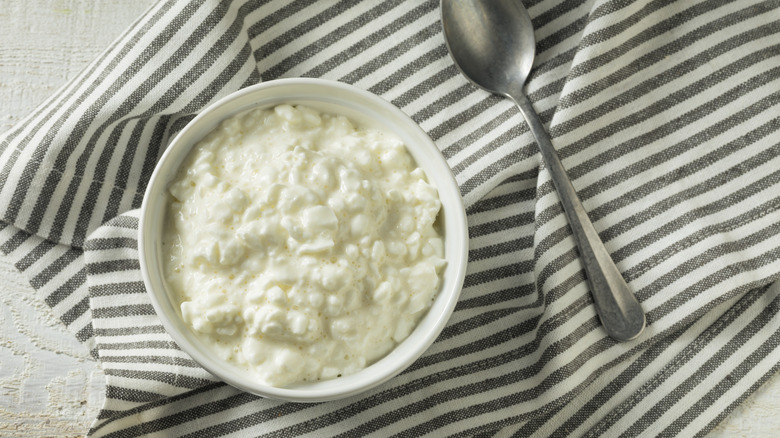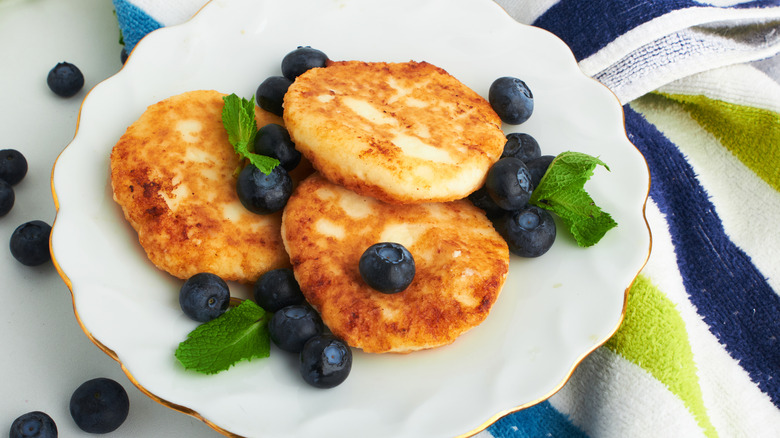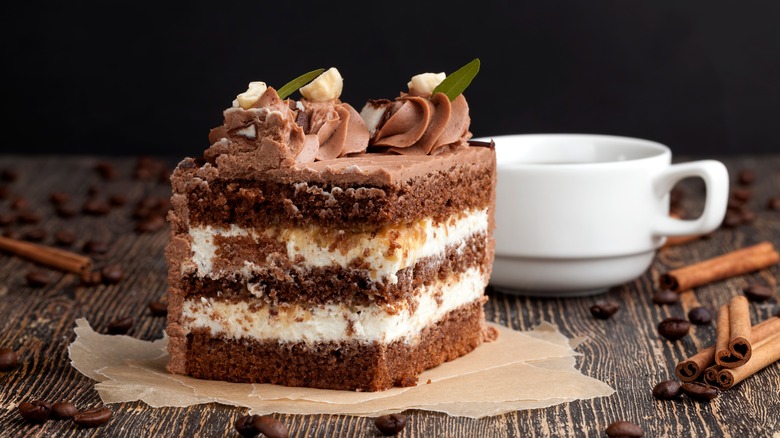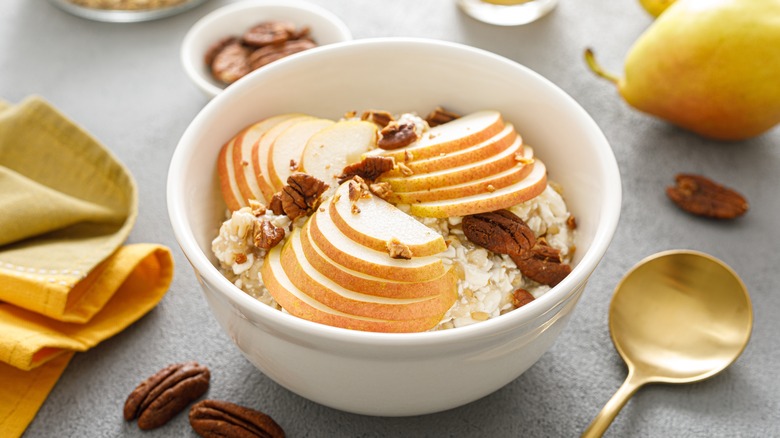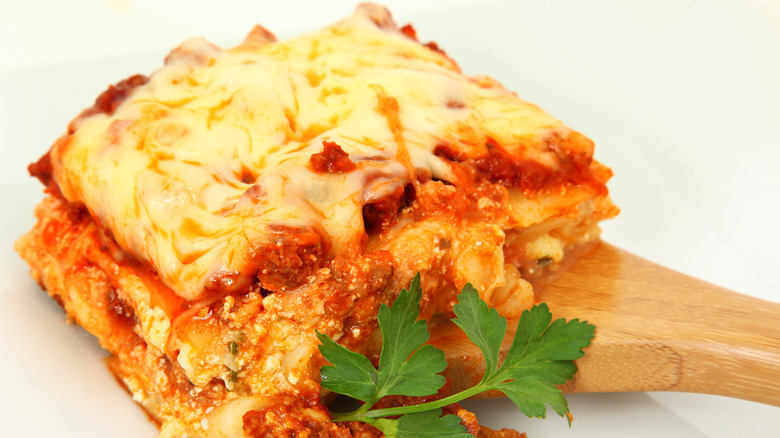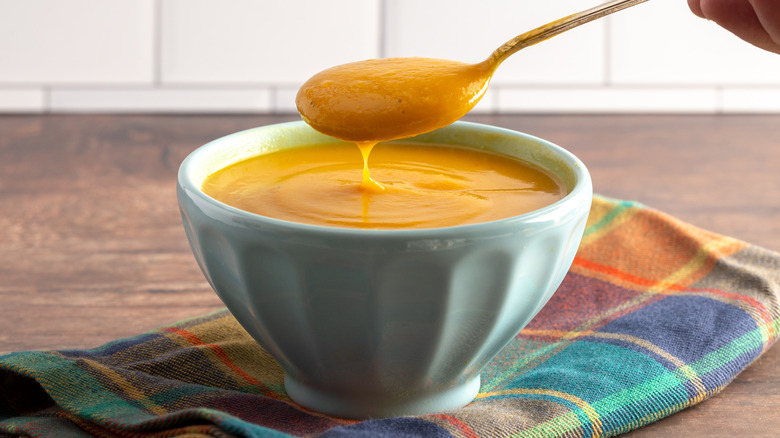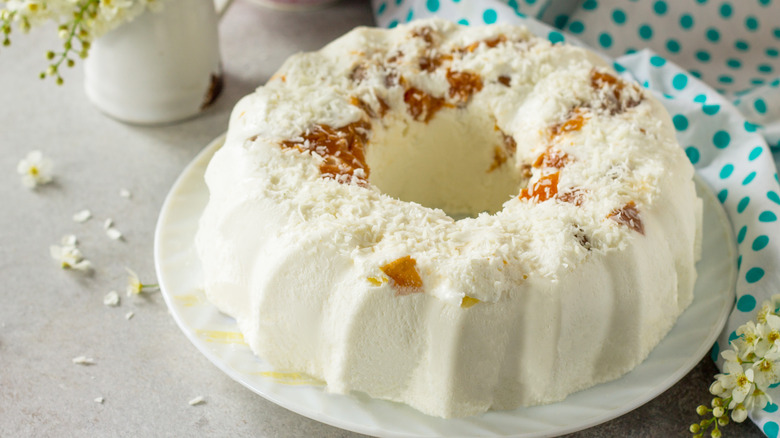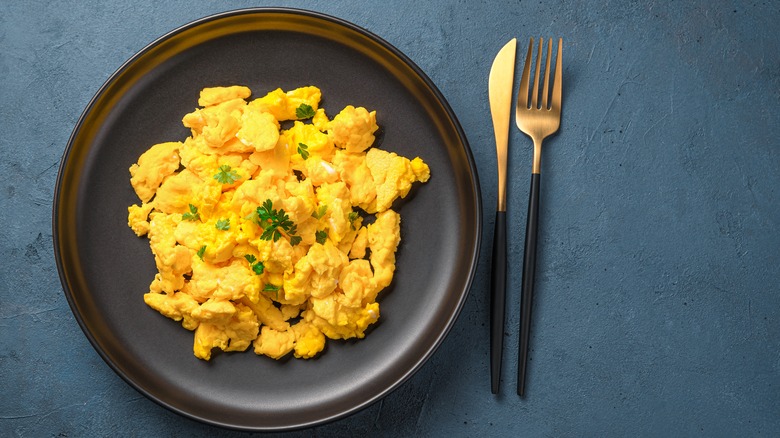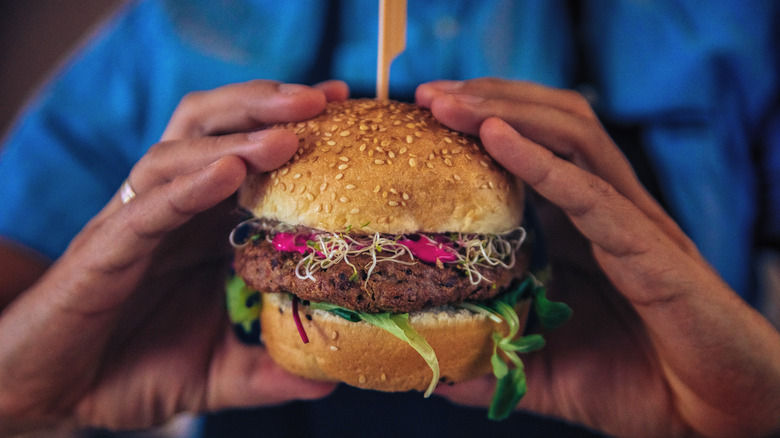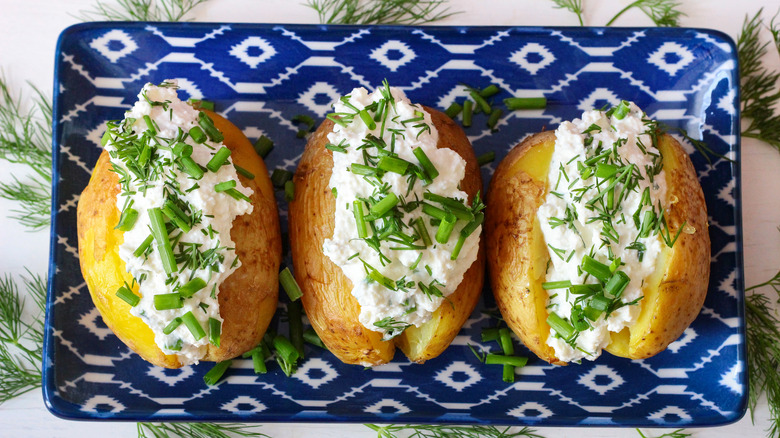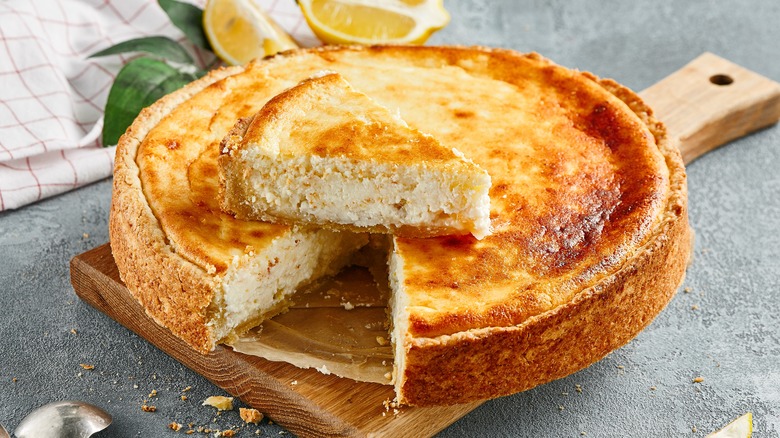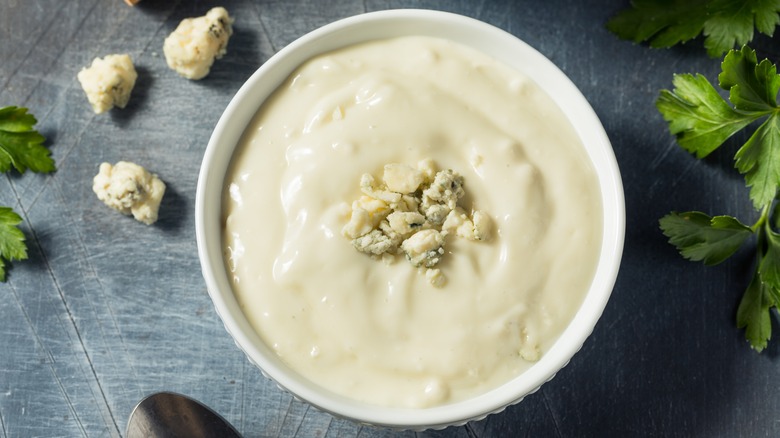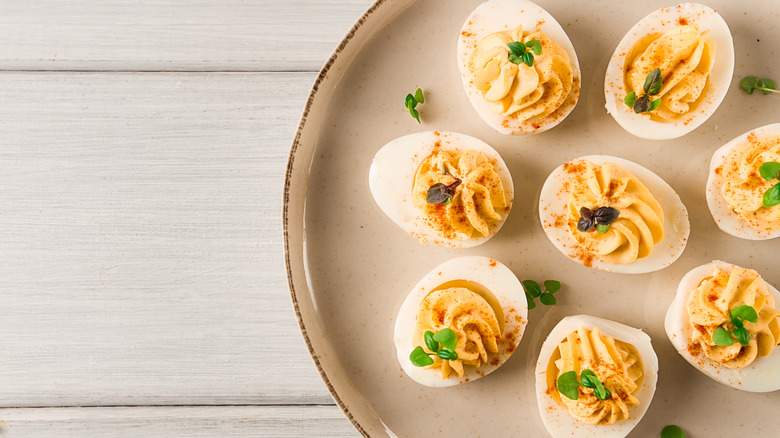13 Ways To Use Cottage Cheese
Cottage cheese is a type of cheese that fits within the realm of what is known as fresh (versus aged) cheeses. It's made by incorporating either a bacterial culture or food-grade acid, like vinegar, into pasteurized milk. This results in curds separating from the whey. Once the whey gets drained from the curds, the curds are cooked for an additional period to eliminate any remaining whey before being rinsed and adding some salt.
While its origins date back to Mesopotamian times and it was commonplace in Ancient Egypt and later Europe, it became popular in the United States in the 1800s. Its name derives from the fact that this type of cheese was typically made in the home or "cottage," meaning it was a rustic peasant cheese that didn't require much elaborate preparation.
Cottage cheese is naturally high in protein, low in carbohydrates, may contain probiotics, is loaded with B vitamins, and is replete with minerals, including calcium, selenium, and phosphorus. It is a remarkably versatile ingredient, but a couple of considerations should be taken when cooking with it. Because it is relatively high in sodium, you should adjust the salt added to a recipe when using cottage cheese. Additionally, if you are cooking with cottage cheese, stay away from non-fat varieties. These contain more sugar and carbohydrates, and the texture can water down your recipes and make them soupy.
Let's look at the myriad ways cottage cheese can be a game changer in pumping up your culinary delights.
Make pancakes and quickbreads fluffier
The use of buttermilk in making pancakes and quickbreads has long gotten used to enhance the texture and flavor of these foods. But why? First, all food, including baked goods, is a product of the complex dance between the primary tastes — sweet, sour, salty, bitter, and umami. Without a balance between these flavors, your tongue may not adequately recognize all the flavors. Adding acidic ingredients, like buttermilk or cottage cheese, can enhance your ability to taste the sweetness of the pancake or banana bread without overwhelming you with sourness.
Additionally, acidic ingredients are crucial in encouraging baking soda to jump into action. Once an acidic liquid interacts with the baking soda, it instantly begins producing bubbles, allowing the batter to puff up, giving it a fluffy, delicate texture. If you forget to purchase buttermilk or want to add a bit of protein and tang, cottage cheese can be substituted one-to-one for buttermilk in any recipe. Indeed, the pH of buttermilk is 4.5, while the pH of cottage cheese is between 4.6 and 4.9, making it virtually identical.
When substituting cottage cheese, you can either add it as is, curds and all, for a slightly more toothsome texture, or place the cottage cheese into a blender or food processor and purée it until smooth and creamy before incorporating it into your batter. Either way, pay attention to the cooking time and doneness of your pancakes or quickbreads. They may require a touch more time to be finished.
Add moisture to cakes and muffins
Most cakes and muffins call for milk, butter, or oil, to add moisture to the batter for a delicate, tender cake. However, sometimes even with the required milk, the final result may yield a dry, crumbly result. This unfortunate texture can be the byproduct of numerous factors ranging from altitude to humidity to type of flour used to whether the recipe ingredients were given in grams versus cups. To add a distinct tang and moisture to your batter, along with extra protein, try incorporating some cottage cheese into the recipe.
You may opt for creamed cottage cheese or dry cottage cheese, depending on the type of cake or muffin you are making. The difference between the two is the addition of heavy cream to the creamed version. There are also three options for curd size — small, medium, or large. When using large curd cottage cheese, you may notice that the curds will brown under high heat, giving the cake or muffin a distinct bumpy texture. If you prefer this not to happen, purée the cottage cheese in a blender or food processor until smooth and creamy before adding it to your batter. A simple ratio for a recipe would be 2 tablespoons of cottage cheese for every 1 cup of milk in the recipe — although this may require a bit of trial and error to establish the exact proportion desired.
Add protein to your smoothies or oatmeal
Smoothies and oatmeal are popular breakfast or snack options for those looking to incorporate more fiber, fruit, and vegetables into their diets. However, without adding protein, you may notice you are feeling hungry rather quickly and need to reach for a sugary snack to tie yourself over until your next meal, which defeats the whole purpose of the healthy smoothie or oatmeal. The key to staving off hunger is ensuring you incorporate adequate protein. While several different types of protein powders exist to fill this niche, these can have a chalky taste and make your smoothie or oatmeal gummy, giving them a texture more like playdough than something you should eat or drink.
Of all the protein sources to add to your smoothies or oatmeal — cottage cheese is one of the best. With 14 grams of protein in a 1/2 cup serving of 1% milk-fat cottage cheese, 70% of the calories in cottage cheese are protein, making it higher in protein than Greek yogurt and milk. About 80% of this protein is casein, which is a slow-absorbing protein. The consumption of slow-absorbing protein has shown to help increase muscle development, as well as boost metabolism.
Add tangy flavor to your sauces or dips
Because of its slightly sour tangy flavor, cottage cheese can be a delightful ingredient added to a cheese sauce, like an Alfredo, or a cheesy dip, such as queso. The only problem with cottage cheese is that, like feta, it is a high-acidity, low-pH cheese, which means it does not melt particularly well on its own. And the lower the milk fat percentage of cottage cheese, the more likely it is not to melt. It can, however, get coaxed into melting in a few ways.
One method to melt cottage cheese is in the microwave. If you add 1 teaspoon or so of butter or oil to the cottage cheese and slowly microwave it 10 seconds at a time, whisking in between each trip in the microwave, you can achieve a mostly homogeneous, creamy texture. Another way around melting cottage cheese is to purée it with equal parts evaporated milk in a food processor or blender before adding it to your sauce or dip, which will remove the lumpy curds and help incorporate it into your recipe.
If you're anything like us, we're fond of the texture of the curds, and therefore we don't mind a few little lumps and bumps in our sauce or dip, particularly if the cottage cheese gets added along with other cheeses that melt more consistently, like cheddar or gruyere. Many Eastern European noodle dishes, like the Hungarian Túrós csusza and the Polish Kluski z Serem, are classically made with cottage cheese mixed with egg noodles for a rustic, stick-to-your-bones meal.
Pump up the probiotics in casseroles
Adding cottage cheese to lasagna as a substitute for ricotta or to macaroni and cheese in addition to other cheeses is a great way to enhance flavor and boost your protein intake. But one of the more exciting benefits of cooking with cottage cheese is its probiotic content. Like other fermented foods, cottage cheese can be a superb source of these tiny little micro-organisms that populate your gut with good bacteria, increasing the health of its microbiome.
A healthy gut microbiome is crucial to overall health for many reasons. First, it is integral to proper digestion and the absorption of vitamins and minerals present in food into our bodies. Next, it is invaluable to maintaining a functional immune system. Third, it can be critical in regulating our mind-gut connection, which has gotten linked to managing anxiety, depression, and other mood disorders. And finally, it can positively impact the delayed onset of chronic illnesses like irritable bowel syndrome, kidney disease, liver disease, and asthma.
The key is to seek out cottage cheese brands containing active or live cultures. Since not all brands do, it is necessary to seek labeling indicating that a brand does have these cultures. Some brands will also list the exact strains of probiotics present in their product, such as Lactobacillus acidophilus, Lactobacillus casei, and Bifidobacterium bifidum. When making a casserole with cottage cheese, you may need to allow extra time for the dish to sit before serving so it doesn't fall apart.
Reduce fat in soups and sauces
Creamy soups and sauces are incredibly luxurious and appealing. They have a velvety mouthfeel that is satiating and can beautifully showcase complex ingredients. However, soups and sauces are often made creamy by incorporating heavy or sour cream. These both contain high levels of saturated fat and cholesterol. A simple way to offset this added fat while still adding creaminess and a bit of tang is to include cottage cheese. Cottage cheese has 93% less saturated fat and 5.6 times less cholesterol than heavy cream. Cottage cheese also has 83% less saturated fat and 71% less cholesterol than sour cream. That's a marked improvement either way.
You can either purée the cottage cheese in a blender or food processor before adding it to soups or sauces or add it straight into the pot if you use an immersion blender. If your recipe calls for milk to provide creaminess to your soup or sauce, you may not gain much by way of lowering your saturated fat or cholesterol, as they are about equal in levels of both. However, cottage cheese has 237% more protein than milk, making it a better alternative there too.
Cut the carbs in puddings or ice cream
Let us be the first to say that substituting cottage cheese for milk in ice cream or pudding will not taste exactly like ice cream or pudding with the full-fat, full-carb iteration of the product. That said, if you want or need to create a satisfying and healthy low-carb sweet treat that will hit the spot when you have a sweet tooth, using cottage cheese instead of milk for pudding or ice cream is fabulous.
Not only is cottage cheese high in protein, 237% higher than milk, but it is also far lower in carbohydrates or sugars, 3% versus 5% for a 1-cup serving — but there is a catch. Most low-fat cottage cheese options have added sugar to offset the fat, rendering them higher in carbs and sugars than their full-fat versions. Also, when referring to full-fat cottage cheese, we are talking about 4% milkfat versus 2%, 1%, or nonfat cottage cheese. The important thing is to check the label on your cottage cheese. Every manufacturer and product is different.
To incorporate cottage cheese into your creamy treats, you must purée your cottage cheese in a blender or food processor to eliminate all the lumpy curds and create a smooth texture. Also, your sweetener will matter if you are focusing on carbs. The best low-carb sweeteners are stevia, sucralose, erythritol, xylitol, monk fruit sugar, and yacon syrup, but they may yield a different texture or mouthfeel to your sweet treat.
Give your egg dishes a lift
Eggs are a miraculous food. You can make sinful desserts, devilish eggs, heartwarming noodles, and delectable breakfast dishes with them. But they require finesse to cook well, particularly when scrambling eggs. They can quickly become rubbery and chewy, making them unpalatable. The key to fluffy, light eggs? Add liquid. When eggs get cooked straight up, their proteins stick together when heated, making them dense. Incorporating some moisture will enable steam to build up between these protein layers, making the eggs puff up. The key is not overdoing it. Too much liquid will make your eggs watery, soggy, and flavorless. Approximately 1 teaspoon per egg is the ideal ratio.
When it comes to liquid, not all are created equal. Plain water will do the trick, but it lacks flavor. Enter cottage cheese for the win. Cottage cheese will provide just the right amount of liquid with a delectable tangy flavor, and the texture of the curds gives the eggs a satiating mouthfeel. The key is to use slightly higher-fat cottage cheese (2% or 4%) versus low-fat cottage cheese (1% or nonfat), which can render the eggs too watery. And do not use creamy cottage cheese. This job requires dry cottage cheese, meaning cottage cheese that hasn't had any extra cream or milk added after straining the whey. Most regular cottage cheese is dry, but it helps to read the label to be sure.
Improve the texture of your veggie burgers
One of the most common issues with veggie burgers is their dense, dry texture. Many ingredients used to make veggie burgers, like beans, lentils, tofu, tempeh, vital wheat gluten, nuts, and grains, can soak up water and bloat up, making them starchy and toothsome. While oil and eggs can add moisture, they come with fat and cholesterol, potentially offsetting some of the nutritional gains of a veggie burger. A brilliant, high-protein solution? You guessed it — cottage cheese.
Not only will cottage cheese increase moisture, but it will also add extra protein, tangy flavor, and more texture. The key is not adding too much moisture — it's a complex balancing act, but worth the effort. Too much liquid can inhibit your veggie burger from holding together when you cook it, making it a veggie scramble rather than a burger. We recommend using dry versus creamy cottage cheese. Additionally, it's best to use full-fat versus low-fat cottage cheese. And finally, try placing the cottage cheese in a strainer lined with cheesecloth and letting it sit for 30 minutes before using it to eliminate any excess liquid.
Keep the tang, ditch the saturated fat on your baked potatoes
Potatoes often get a bad rap. We think they are a starchy, high-carb food that we should avoid at all costs, but this may not be accurate. Potatoes are loaded with fiber if their skins are left intact, have high levels of protein-building amino acids, and are loaded with vitamins and minerals. The key is how you cook them. Turning them into fries, chips, and au gratin might rock, but they're not the healthiest options. Baking them is the way to go. The biggest pitfall to baked potatoes is toppings. Loading a potato with sour cream, bacon, and cheese is delicious, but they may confer a ton of calories and fat. Cottage cheese is a healthier and equally luscious topping for a baked potato.
Cottage cheese has 356% more protein than sour cream, 83% less saturated fat, and 71% less cholesterol. And because it is a cheese, the heat of the potato will begin to slowly break down the curds, making them little oozy bites of goodness when you eat them. For a delicious combination, mix cottage cheese with chopped green onions, fresh dill, a hint of lemon juice or zest, and a dash of sumac for a zesty, bright topping. For some crunch, consider toasted sunflower seeds, almonds, or pistachios, which are loaded with antioxidants and have a great umami taste.
Substitute it for cream cheese in your cheesecake
Cheesecake is one of those desserts that tend to polarize people. You either love it or hate it. For some, it is a creamy, slightly tangy dessert that is the perfect ending for a meal. For others, the texture of cheesecake and its slight sourness is off-putting. It isn't a matter of right or wrong, just of taste.
However, the star of a classic cheesecake is typically cream cheese, which is remarkably versatile and delicious, but maybe not the most healthful of ingredients to cook with. It is relatively high in saturated fat and cholesterol. A tasty and effective alternative is cottage cheese. Cottage cheese is 81% higher in protein, 92% lower in saturated fat, lower in trans fats, and 4.9 times lower in cholesterol than cream cheese. And in this case, there isn't too much of a difference in texture between the two or even flavor.
When substituting cream cheese with cottage cheese, you can use them in a one-to-one ratio.However, it may require a bit of cream or half and half to the cottage cheese to obtain a similar texture, depending upon the milk fat percentage and type of cottage cheese you are using (creamy versus dry). And always purée your cottage cheese thoroughly in a blender or food processor to obtain a smooth texture before adding it to your cheesecake recipe.
Add it to a creamy salad dressing
We know we should all be eating more fruits and vegetables in our diets, and having a big salad seems like a great way of having a "healthy" meal instead of a fatty burger and fries or pizza. But is it? You'd be surprised at how some salads might end up higher in calories and fat than burgers or pizzas. Part of this is because of the toppings added, like bacon, fried chicken, or tons of cheese. But, it more likely has to do with the salad dressing, especially creamy salad dressings like ranch or blue cheese, which are often made using mayonnaise or sour cream.
Fear not, however, as you can manufacture a satisfying, tart, creamy dressing by substituting cottage cheese for sour cream and mayonnaise in your favorite creamy salad dressings. While some recipes call for adding a hint of milk and lemon juice to your cottage cheese to substitute it for sour cream, we find that unnecessary, particularly in a salad dressing where you will add acidity in the form of vinegar. All you need to do is purée the cottage cheese with a blender or food processor to create a creamy texture. The same goes for substituting mayonnaise with cottage cheese. For a hint of added umami flavor, you may consider adding just a pinch of Worcestershire sauce to the recipe but don't overdo it.
Make it your secret weapon in deviled eggs
We think deviled eggs are devilishly good. There is not a Fourth of July barbecue or potluck that goes by without someone bringing a variation on this classic. We love them but don't love what they can do to our waistlines, especially since polishing off three (or 10 because you know you want to!) of these lovely bite-sized snacks at a time is easy. What to do if you want to lighten up your deviled eggs without sacrificing any flavor? Add cottage cheese.
Mayonnaise is often the key to creating the perfect creamy filling for a deviled egg, but we know that mayo can be high in calories and fat, making it something to use sparingly. While cottage cheese may not have quite the punch of flavor that mayonnaise does, it has the creaminess and tang without all the fat, fewer calories, and a ton of protein. When substituting cottage cheese for mayo, you can purée it if you prefer your filling to be creamier, but you don't need to. We enjoy the texture of the curds.
We also recommend adding a punch of extra flavor either in the form of some Worcestershire sauce or just a pinch of anchovy paste — which is one of the secret ingredients in Worcestershire sauce. It'll give it that pop of salt and umami richness that may get lost without the mayo. And whatever you do, do not forget to top these off with good-quality Hungarian smoked paprika.
